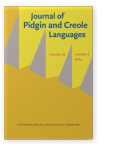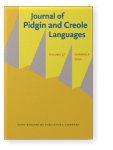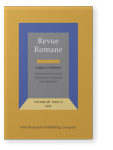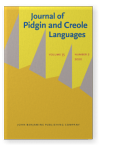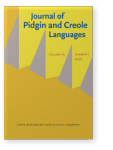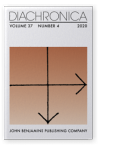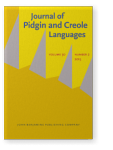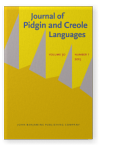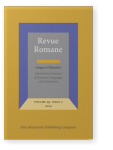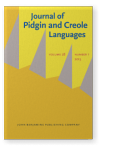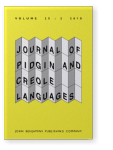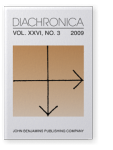Bart Jacobs
List of John Benjamins publications for which Bart Jacobs plays a role.
Journal
2024 Skepi Creole Dutch: The Rodschied Papers Journal of Pidgin and Creole Languages 39:2, pp. 394–408 | Article
This paper presents new Skepi Creole Dutch data from the late-18th century, found in the work of the German scholar Ernst Karl Rodschied. The creole data include pronominal and verbal paradigms, a short 60-word excerpt from a private letter, and around two dozen names for local flora. After… read more
2021 How ‘Portuguese’ are Palenquero and Chabacano really? Revue Romane 56:2, pp. 235–266 | Article
A long-lasting debate within creole studies concerns the scarcity of Spanish-based creoles and the theoretical implications this may have. However, there is no agreement as to how many genuinely Spanish-based creoles there are in the world, and identifying the size of that group can generate… read more
2020 Skepi Dutch Creole: The Youd Papers Journal of Pidgin and Creole Languages 35:2, pp. 360–380 | Short note
In this article we present newly found lexical and grammatical data pertaining to Skepi, the Dutch-lexified creole which is now extinct but was once widespread in the Essequibo area of what is today the Republic of Guyana. The source of this new material are the linguistic notes contained in the… read more
2020 Chavacano (Philippine Creole Spanish): Are the varieties related? Journal of Pidgin and Creole Languages 35:1, pp. 88–124 | Article
This article argues that the three existing varieties of Chavacano are descendents of one and the same proto-variety. While their direct relatedness used to be agreed upon, it has recently been questioned to differing extents by Lipski (e.g. 1992, 2010, 2013) and Fernández (e.g. 2006, 2011).… read more
2020 Palenquero origins: A tale of more than two languages Diachronica 37:4, pp. 540–576 | Article
Palenquero is a Spanish-lexified creole spoken in Columbia. We argue that existing hypotheses regarding its birth are problematic in several regards. This article addresses the inconsistencies in these hypotheses and provides an alternative, more coherent account. More precisely, we take issue… read more
2015 The discovery, nature, and implications of a Papiamentu text fragment from 1783 Journal of Pidgin and Creole Languages 30:1, pp. 44–62 | Article
In this paper, we discuss the recent discovery of four letters written in 1783, one of which is written fully in Papiamentu, the other three comprising Papiamentu fragments. The data in these constitute one of the earliest written attestations of Papiamentu. We first provide a brief overview of the… read more
2014 Whatever happened to the Occitan go-past? Insights from the dialects of Gascony and Guardia Piemontese Revue Romane 49:2, pp. 177–203 | Article
This article explores the history and present state of the Occitan go-past. Also known as the perfet perifràstic, this is a characteristic and well-studied feature of the Catalan grammar (vaig cantar go.1sg.pres.ind-sing ‘I sang’), but its existence in Occitan has been ignored to the extent that… read more
2013 Reassessment of the Portuguese contribution to the Papiamentu lexicon Journal of Pidgin and Creole Languages 28:1, pp. 154–165 | Article
2012 Embedding Papiamentu in the mixed language debate Journal of Historical Linguistics 2:1, pp. 52–82 | Article
This paper takes as a point of departure the hypothesis that Papiamentu descends from Upper Guinea Portuguese Creole (a term covering the sister varieties of the Cape Verde Islands and Guinea-Bissau and Casamance), speakers of which arrived on Curaçao in the second half of the 17th century,… read more
2010 Upper Guinea Creole: Evidence in favor of a Santiago birth Journal of Pidgin and Creole Languages 25:2, pp. 289–343 | Article
This paper addresses the debate on the place of origin of the Upper Guinea branch of Portuguese Creole (UGPC) as spoken in Guinea-Bissau and Casamance (GBC) and on the Santiago Island of Cape Verde (SCV). The hypothesis that UGPC emerged on Santiago rather than on the mainland is underpinned both… read more
2009 The Upper Guinea origins of Papiamentu: Linguistic and historical evidence Diachronica 26:3, pp. 319–379 | Article
This paper deals with the linguistic and historical relationships between Papiamentu and Upper Guinea Creole as spoken on the Santiago island of Cape Verde and in Guinea-Bissau and Casamance. In the linguistic section, the hypothesis that Papiamentu is a relexified offshoot of an early Upper Guinea… read more
